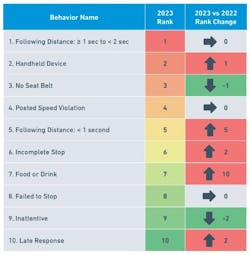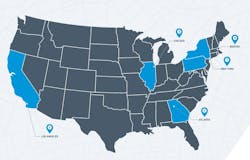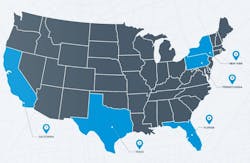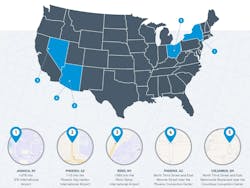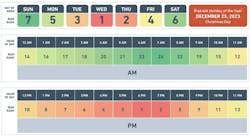Using data from 40 billion miles traveled in 2023, video safety and video telematics provider Lytx released its 2024 State of the Data report, identifying risks and roadway behaviors that fleets should be aware of to ensure the safety of their drivers and the motoring public.
A record 3.26 trillion miles were traveled on U.S. roadways in 2023, according to the Federal Highway Administration. Capturing 140 million driving behaviors, 29 million risky events, and enabling the coaching of 24 million events through its platform in 2023, Lytx found that more miles driven equate to higher safety risks. From 2022 to 2023, driving risk increased by almost 10% while collisions increased by 3%.
See also: Unraveling the gridlock: How traffic congestion stifles urban growth and quality of life
“Road travel surged to record highs in 2023, and with more vehicles come more risks, as well as increased logistical complexity,” Lytx Chairman and CEO Brandon Nixon, said. “It’s crystal clear that the need for safety and efficiency amid increasingly congested roadways has never been stronger.”
The Lytx safety report identified three factors contributing to risky or unsafe driving, among others; those three include risky driving behaviors, the top five riskiest areas to travel, and the riskiest times to be on the road.
Lytx’s complete list of top 10 riskiest behaviors includes:
- Following distance of greater than or equal to one second to less than two seconds
- Use of handheld devices
- Not wearing a seat belt
- Violating posted speed limits
- Following distance of less than one second
- Not making a complete stop
- Drinking or eating while driving
- Failure to stop
- Inattentiveness
- Late response
10 risky driving behaviors
Compared to 2022, Lytx’s top five risky driving behavior risks saw movement. While the top risk—a following distance of greater than or equal to one second to less than 2 seconds—and the fourth risk—posted speed violations—remained the same, there were changes to the second, third, and fifth riskiest driving behaviors.
The use of handheld devices rose one spot from third in 2022 to second in 2023. Down from the second highest risk in 2022 to the third highest risk in 2023 was not wearing a seat belt. The most significant change to the top five riskiest driving behaviors from 2022 to 2023 was a following distance of less than one second, which rose from number 10 in 2022.
See also: How dash cams, driver coaching tools could help fleets reduce costs
Lytx's complete list of top riskiest cities to drive includes:
- New York
- Los Angeles
- Chicago
- Atlanta
- Boston
Top 5 riskiest areas to drive
Riskiest cities to drive
The top riskiest city for road travel is New York City. This is the third year in a row that Lytx data has shown New York to be the riskiest city to drive, and its risk is double that of the second riskiest city, Los Angeles. While it dropped to the seventh riskiest city in 2022, Atlanta is back in the top five for 2023 as the fourth riskiest city for driving. Philadelphia, while out of the top five in 2023, deserves recognition for its improvement, moving down from the second-riskiest city in 2022 to the eighth-riskiest city in 2023.
See also: Which cities have the worst roads?
Lytx's complete list of top riskiest states to drive includes:
- California
- New York
- Texas
- Florida
- Pennsylvania
Riskiest states to drive
For the third time in four years, Lytx crowned California as 2023’s riskiest state to drive, followed by New York, Texas, Florida, and Pennsylvania.
“California continues to have the most hazardous roads overall, likely due to its large population, numerous metropolitan areas, and high traffic volumes,” the report states.
See also: Report on deadliest trucking states calls on Congress for change
Lytx's complete list of top riskiest U.S. roadways include:
- I-678 leading to JFK Airport in Jamaica, New York
- I-10 leading to Sky Harbor Airport in Phoenix, Arizona
- I-580 leading to Reno-Tahoe Airport in Reno, Nevada
- North Third Street and East Monroe Street near the Phoenix Convention Center in Arizona
- North Third Street and East Nationwide Boulevard near the Columbus Convention Center in Ohio
Riskiest U.S. roadways
The riskiest roadways in the U.S. are close to airports and convention centers, according to Lytx data. The riskiest roadway in the U.S. is in Jamaica, New York, on Interstate 678 into JFK Airport. The second-riskiest road is in Phoenix, Arizona, on I-10 into Sky Harbor Airport. Next is I-580 in Reno into the Reno-Tahoe Airport in Nevada, North Third Street and East Monroe Street near the Phoenix Convention Center in Arizona, and North Third Street and East Nationwide Boulevard near the Columbus Convention Center in Ohio.
“Convention centers have joined airports as risky areas for collisions,” Kyle Warlick, senior analyst at Lytx Client Intelligence, said in the report. “The combination of congestion, frequent passenger drop-offs and pick-ups, and visitors who may be less familiar with the roads make these areas especially hazardous.”
Times when being on the road poses the most risk
Riskiest times of the day to drive
In many instances, more traffic on the roads can lead to more risk. This is especially true during commute hours or rush hour timeframes. However, Lytx data uncovered that driving during afternoon commute hours, from 4 p.m. to 7 p.m., is three times riskier than during morning commute hours. Overall, hours in the p.m. are riskier to drive, according to Lytx data. The 6 p.m. hour is the riskiest time to be on the road, followed by 7 p.m., 5 p.m., 4 p.m., and 8 p.m. The safest time to drive in the U.S. is from 5 a.m. to 8 a.m., with the 7 a.m. hour being the safest time to drive.
See also: Tips and tricks for safer night driving
Riskiest days of the week to drive
The riskiest driving days of the week are Wednesday and Thursday, according to Ltyx data, with the highest collisions per vehicle occurring on Wednesday and the second highest on Thursday. Sunday is the safest day of the week to drive followed by Saturday.
Riskiest holidays to drive
The worst day of the year to travel is Christmas Day (Dec. 25). The safest holiday to be on the road is Halloween (Oct. 31).
“On Christmas Day, roads can be busy with holiday travelers rushing to reach their destinations in time, with winter weather potentially playing a role, too,” Warlick said in the report. “On the other hand, those who celebrate Halloween tend to want to be home and stay off the roads.”
Lytx ranked the U.S. holidays from the riskiest to the safest in 2023:
- Christmas Day
- President’s Day
- New Years Eve
- Marting Luther King Day
- Memorial Day
- Christmas Eve
- Independence Day
- New Years Day
- Veteran’s Day
- Thanksgiving Day
- Labor Day
- Halloween
Silver linings of the Lytx safety report
“Across the board, all industries saw an increase in near collisions from 2022 to 2023,” the report stated. However, while there was an increase in near collisions, the increase in actual collisions was only 3% compared to last year.
“This suggests that, as roads got more congested, commercial drivers seemed to be getting better at avoiding collisions on a per-mile basis through defensive driving skills and/or more attentive driving,” the report stated.
See also: How real-time coaching can boost fleet efficiency and safety
This assumption underscores the importance of driver coaching, and video telematics can help fleet managers coach more effectively. “I want to put my drivers in the winning position,” Jeff Martin, Lytx’s VP of global sales strategy, told FleetOwner at an industry event in the fall. “I want to protect myself, my company, and certainly, all motorists.”
About the Author
Jade Brasher
Senior Editor Jade Brasher has covered vocational trucking and fleets since 2018. A graduate of The University of Alabama with a degree in journalism, Jade enjoys telling stories about the people behind the wheel and the intricate processes of the ever-evolving trucking industry.

